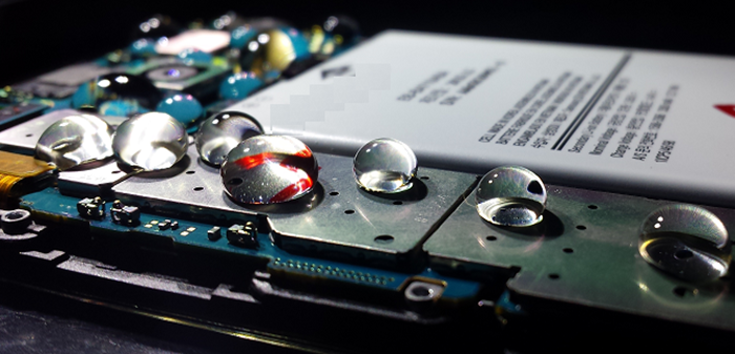By Gina Roos, editor-in-chief
P2i recently launched its Dunkable system-level waterproofing solution that protects smartphones to IPX8 levels over the lifetime of the device, enabling smartphones to operate even when submerged in water for long periods of time and the outer case is breached. The nano-coating system delivers IPX8 protection to the handset, the printed circuit board (PCB), and other components and will not degrade over the device’s lifetime through impact, heat, environmental stress, or contact with solvents or soap, according to the company.
Tests show that devices treated with the Dunkable coating passed the IEC IPX8 with no corrosion after 0 and 24 hours and salt-fog tests (2 hours 5% salt spray, 22 hours @ 50° C, 95% relative humidity). The device performance tests showed no effect on RF, audio, or optical integrity, said P2i.
In addition, results were retained in accelerated lifetime-simulation tests (P2i’s rock-tumble tests that simulate real-world use for the device’s lifetime):
- In extremes of temperature and humidity (−10°C to 65° C, 93% relative humidity for 72 hours)
- Thermal shock tests (MIL-STD-810F, −40°C to 85°C)
- Drop tests (falling 1.5 m under MIL-STD-810G standards)
Through a multi-chemistry approach, the company can customize the technology to an OEM’s manufacturing process and handset design. The coating can also be reapplied if the handsets are repaired and/or components are replaced.

An exposed handset PCB protected by P2i. (Image: P2i)
“Mechanical seals currently used to protect handsets to IPX7 and -8 levels only act as a barrier to water, allowing short-circuiting if water enters the device via a cracked screen1 or a de-laminated seal2,3 ,” said P2i. “They also use space that could be used for larger batteries, which will be essential for managing the power demands of 5G modems.”
Other benefits of the technology include increased reliability and durability of the handsets and a reduction in the need and cost of refurbishing, said P2i.
“Dunkable is a world first and represents a step change in the level of waterproofing available to handset manufacturers,” said Ady Moores, CEO of P2i, in a press release. “The launch means that for the first time, OEMs have access to the most advanced water protection capabilities that can be rolled out on virtually all form factors … not just the usual square designs.”
P2i will initially target the smartphone market for the technology, although it can be used to protect all kinds of gadgets, including tablets, wearables, and other consumer devices as well as industrial systems. The company will demonstrate the technology for the first time at the Mobile World Conference (MWC), Congress Square, CS126, showing treated handsets switched on and submerged in a tank of water with the electronics exposed.
Notes:
1. A 2015 survey of 6,019 people by Motorola estimated that 21% of smartphone owners had at least one smartphone with a cracked screen; 43% of those wouldn’t repair it, and 23% continued to use the phone even when the crack was bad enough to cut them.
2. Motorola Care cites that the average time from a phone’s purchase to breaking it is just 10 weeks. It also finds that 28% of consumers will drop their phone into liquid, such as the bath, toilet, or rivers.
3. Feedback from repair centers to P2i suggests that about 15% of IPX8 devices fail air-pressure tests within two weeks of activation.
Advertisement
Learn more about Electronic Products Magazine





